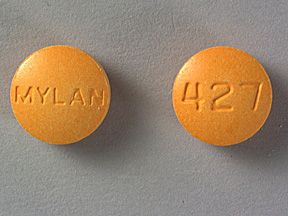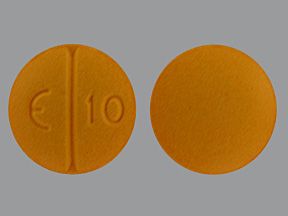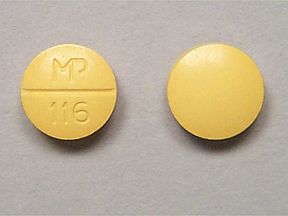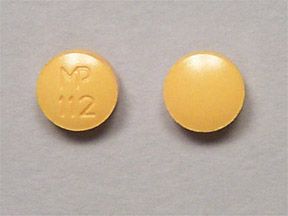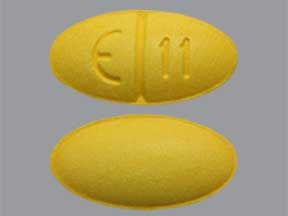Highlights for sulindac
- Sulindac oral tablet is available as a generic drug. It doesn’t have a brand-name version.
- Sulindac only comes as a tablet you take by mouth.
- Sulindac is used to treat different types of arthritis, shoulder pain, and ankylosing spondylitis.
FDA warnings
- This drug has black box warnings. These are the most serious warnings from the Food and Drug Administration (FDA). Black box warnings alert doctors and patients about drug effects that may be dangerous.
- Dangerous heart events warning: Sulindac isn’t recommended if you have heart disease or risks for heart disease, such as high blood pressure. It may increase your risk of blood clots, heart attack, and stroke, which may be fatal (cause death). Your risk may be higher if you take sulindac at high doses or for a long time. This drug can cause heart problems even if you don’t have risks factors for heart disease. You shouldn’t take sulindac if you’ll be having coronary artery bypass graft surgery. Your risk of heart attack or stroke may increase if you take sulindac to treat pain before or after your surgery. Also, avoid taking sulindac after a recent heart attack unless your healthcare provider tells you to.
- Dangerous stomach problems warning: Taking sulindac increases your risk of stomach bleeding, ulcers, or small holes in the lining of your digestive system, which can be fatal. These events may occur at any time and without any symptoms. You’re at a higher risk if you’re over the age of 65 years.
Other warnings
Sulindac is a prescription drug. It comes as an oral tablet.
Sulindac is only available as a generic drug. Generic drugs usually cost less than brand-name versions.
Why it’s used
Sulindac is used to treat pain and redness, swelling, and inflammation from different types of arthritis, ankylosing spondylitis, and short-term shoulder pain. Sulindac is used to treat:
- osteoarthritis
- rheumatoid arthritis
- ankylosing spondylitis
- acute gout symptoms
- acute shoulder pain
How it works
Sulindac belongs to a class of drugs called nonsteroidal anti-inflammatory drugs (NSAIDs). NSAIDs help reduce pain, inflammation, and fever.
It isn’t known how sulindac works to decrease pain. It may help reduce swelling by lowering levels of prostaglandin, a hormone-like substance that usually causes inflammation.
Sulindac oral tablet doesn’t cause drowsiness, but it can cause other side effects.
More common side effects
The more common side effects that can occur with sulindac include:
- stomach pain
- heartburn
- nausea
- diarrhea
- constipation
- rash
- dizziness
- headache
If these effects are mild, they may go away within a few days or a couple of weeks. If they’re more severe or don’t go away, talk to your doctor or pharmacist.
Serious side effects
Call your doctor right away if you have serious side effects. Call 911 if your symptoms feel life-threatening or if you think you’re having a medical emergency. Serious side effects and their symptoms can include the following:
- Chest pain or heart attack. Symptoms of heart attack can include:
- chest pain
- chest tightness
- sweating
- shortness of breath
- heartburn/indigestion
- arm pain
- fatigue
- Stroke. Symptoms can include:
- weakness in one part or side of your body
- slurred speech
- High blood pressure
- Swelling in your arms and legs, hands and feet, face, or throat
- Stomach bleeding and ulcers. Symptoms can include:
- vomiting blood
- bloody stools
- black and sticky stools
- Skin reactions. Symptoms can include:
- rash
- blisters
- Allergic reactions, such as itching
- Liver problems. Symptoms can include:
- yellowing of your skin or the whites of your eyes
- Asthma attacks. Symptoms can include:
- shortness of breath
- trouble breathing
Disclaimer: Our goal is to provide you with the most relevant and current information. However, because drugs affect each person differently, we cannot guarantee that this information includes all possible side effects. This information is not a substitute for medical advice. Always discuss possible side effects with a healthcare provider who knows your medical history.
Sulindac oral tablet can interact with other medications, vitamins, or herbs you may be taking. An interaction is when a substance changes the way a drug works. This can be harmful or prevent the drug from working well.
To help avoid interactions, your doctor should manage all of your medications carefully. Be sure to tell your doctor about all medications, vitamins, or herbs you’re taking. To find out how this drug might interact with something else you’re taking, talk to your doctor or pharmacist.
Examples of drugs that can cause interactions with sulindac are listed below.
Nonsteroidal anti-inflammatory drugs (NSAIDs)
Sulindac is an NSAID. Combining it with other NSAIDs increases your risk of stomach bleeding and ulcers. Examples of other NSAIDs include:
- aspirin
- ibuprofen
- naproxen
- diclofenac
- indomethacin
- meloxicam
- ketorolac
- ketoprofen
Blood pressure drugs
Taking sulindac with these drugs may reduce their blood pressure-lowering effects. Examples of these drugs include:
- angiotensin-converting enzyme (ACE) inhibitors such as:
- enalapril
- captopril
- lisinopril
- angiotensin receptor blockers such as:
- valsartan
- losartan
- candesartan
- diuretics such as:
- furosemide
- hydrochlorothiazide
Anticoagulants
Taking sulindac with anticoagulants increases your risk of bleeding. Examples of these drugs include:
- warfarin
- dabigatran
- rivaroxaban
- edoxaban
Bipolar disorder drug
Taking lithium with sulindac may increase the levels of lithium in your body. This can cause dangerous effects. Your doctor may monitor your lithium levels if you take these medications together.
Transplant drug
Taking cyclosporine with sulindac may increase the levels of cyclosporine in your body. This can cause dangerous effects. Your doctor may monitor your cyclosporine levels if you take these medications together.
Disclaimer: Our goal is to provide you with the most relevant and current information. However, because drugs interact differently in each person, we cannot guarantee that this information includes all possible interactions. This information is not a substitute for medical advice. Always speak with your healthcare provider about possible interactions with all prescription drugs, vitamins, herbs and supplements, and over-the-counter drugs that you are taking.
This drug comes with several warnings.
Allergy warning
Sulindac can cause a severe allergic reaction. Symptoms may include:
- trouble breathing
- swelling of your face or throat
If you develop these symptoms, call 911 or go to the nearest emergency room.
Don’t take this drug again if you’ve ever had an allergic reaction to it. Taking it again could be fatal (cause death).
Alcohol interaction warning
Drinking alcohol while taking sulindac increases your risk of stomach bleeding or ulcer.
Warnings for people with certain health conditions
For people with high blood pressure: Sulindac may cause you to develop high blood pressure or make existing high blood pressure worse. Check your blood pressure before you start and while you take sulindac.
For people with ulcers or stomach bleeding: This medication increases your risk of stomach bleeding if you have a history of ulcers or stomach bleeding.
For people with heart disease: This medication may cause fluid retention, which is a problem with heart disease. Watch for symptoms of fluid retention while you take sulindac if you tend to retain water or you have heart failure.
For people with asthma: You shouldn’t take sulindac if you have a history of asthma, hives, or allergic reaction after taking aspirin or other nonsteroidal anti-inflammatory drugs (NSAIDs). You may experience a similar reaction to this drug, which may be deadly.
Warnings for other groups
For pregnant women: Sulindac is a category C pregnancy drug. That means two things:
- Research in animals has shown adverse effects to the fetus when the mother takes the drug.
- There haven’t been enough studies done in humans to be certain how the drug might affect the fetus.
Talk to your doctor if you’re pregnant or planning to become pregnant. Sulindac should be used during pregnancy only if the potential benefit justifies the potential risk.
If you become pregnant while taking this drug, call your doctor right away.
For women who are breastfeeding: It isn’t known if sulindac is passes through breast milk. If it does and you breastfeed, your child may be at risk of side effects from this drug. You and your doctor may decide whether you’ll take sulindac or breastfeed.
For seniors: If you’re older than 65 years, your body may process this drug more slowly. Your doctor may start you on a lowered dosage so that too much of this drug doesn’t build up in your body. Too much of the drug in your body can be dangerous.
For children: It hasn’t been established that sulindac is safe and effective for use in children younger than 18 years.
This dosage information is for sulindac oral tablet. All possible dosages and forms may not be included here. Your dose, form, and how often you take it will depend on:
- your age
- the condition being treated
- how severe your condition is
- other medical conditions you have
- how you react to the first dose
Drug form and strengths
Generic: Sulindac
- Form: oral tablet
- Strengths: 150 mg, 200 mg
Dosage for osteoarthritis
Adult dosage (ages 18–64 years)
Typical dosage: 150 mg taken twice per day in evenly spaced doses (for a total of 300 mg per day).
Child dosage (ages 0–17 years)
A dosage for children younger than 18 years hasn’t been established.
Senior dosage (ages 65 years and older)
Older adults may process drugs more slowly. A normal adult dose may cause levels of the drug to be higher than normal. If you’re a senior, you may need a lower dosage or you may need a different treatment schedule.
Dosage for rheumatoid arthritis
Adult dosage (ages 18–64 years)
Typical dosage: 150 mg taken twice per day in evenly spaced doses (for a total of 300 mg per day).
Child dosage (ages 0–17 years)
Dosage for children younger than 18 years hasn’t been established.
Senior dosage (ages 65 years and older)
Older adults may process drugs more slowly. A normal adult dose may cause levels of the drug to be higher than normal. If you’re a senior, you may need a lower dosage or you may need a different treatment schedule.
Dosage for ankylosing spondylitis
Adult dosage (ages 18–64 years)
Typical dosage: 150 mg taken twice per day in evenly spaced doses (for a total of 300 mg per day).
Child dosage (ages 0–17 years)
Dosage for children younger than 18 years hasn’t been established.
Senior dosage (ages 65 years and older)
Older adults may process drugs more slowly. A normal adult dose may cause levels of the drug to be higher than normal. If you’re a senior, you may need a lower dosage or you may need a different treatment schedule.
Dosage for acute shoulder pain
Adult dosage (ages 18–64 years)
Typical dosage: 200 mg taken twice per day in evenly spaced doses (for a total of 400 mg per day). Therapy usually lasts 7 to14 days.
Child dosage (ages 0–17 years)
Dosage for children younger than 18 years hasn’t been established.
Senior dosage (ages 65 years and older)
Older adults may process drugs more slowly. A normal adult dose may cause levels of the drug to be higher than normal. If you’re a senior, you may need a lower dosage or you may need a different treatment schedule.
Dosage for acute gouty arthritis
Adult dosage (ages 18–64 years)
Typical dosage: 200 mg taken twice per day in evenly spaced doses (for a total of 400 mg per day). Therapy usually lasts seven days.
Child dosage (ages 0–17 years)
Dosage for children younger than 18 years hasn’t been established.
Senior dosage (ages 65 years and older)
Older adults may process drugs more slowly. A normal adult dosage may cause levels of the drug to be higher than normal. If you’re a senior, you may need a lower dosage or you may need a different treatment schedule.
Special dosage considerations
For people with liver disease: Liver disease may make it harder to clear this drug from your body. This could cause drug levels to get too high. If you have liver disease, your daily dosage may be lowered.
For people with kidney disease: Kidney disease may make it harder to clear this drug from your body. If you have kidney disease, your daily dosage may be lowered.
Disclaimer: Our goal is to provide you with the most relevant and current information. However, because drugs affect each person differently, we cannot guarantee that this list includes all possible dosages. This information is not a substitute for medical advice. Always speak with your doctor or pharmacist about dosages that are right for you.
Sulindac oral tablet is used for short-term treatment when used for shoulder pain or gouty arthritis. It may be a long-term treatment when used for osteoarthritis, rheumatoid arthritis, or ankylosing spondylitis.
This drug comes with risks if you don’t take it as prescribed by your doctor.
If you stop taking the drug or don’t take it at all: You may experience more pain caused by your condition.
If you miss doses or don’t take the drug on schedule: Your medication may not work as well or may stop working completely. For this drug to work well, a certain amount needs to be in your body at all times.
If you take too much: You could have dangerous levels of the drug in your body. Symptoms of an overdose of this drug can include:
- nausea
- vomiting
- dizziness
- black or bloody stools
- coughing up blood
In rare cases, taking too much of this drug can result in death. If you think you’ve taken too much of this drug, call your doctor or seek guidance from the American Association of Poison Control Centers at 1-800-222-1222 or through their online tool. But if your symptoms are severe, call 911 or go to the nearest emergency room right away.
What to do if you miss a dose: If you miss a dose and it’s more than a few hours until your next dose, take it as soon as you can. If it’s just a few hours until your next dose, skip the dose and take the next one at the usual time.
Never try to catch up by taking two doses at once. This could result in dangerous side effects.
How to tell if the drug is working: You should have less pain from your condition.
Keep these considerations in mind if your doctor prescribes sulindac for you.
General
- Take this medication with food to reduce stomach irritation and damage.
- You can cut or crush the oral tablets.
Storage
- Store this medication at room temperature between 68°F and 77°F (20°C and 25°C).
- Don’t freeze this drug.
- Keep this drug away from light.
- Don’t store this medication in moist or damp areas, such as bathrooms.
Refills
A prescription for this medication is refillable. You should not need a new prescription for this medication to be refilled. Your doctor will write the number of refills authorized on your prescription.
Travel
When traveling with your medication:
- Always carry your medication with you. When flying, never put it into a checked bag. Keep it in your carry-on bag.
- Don’t worry about airport X-ray machines. They can’t harm your medication.
- You may need to show airport staff the pharmacy label for your medication. Always carry the original prescription-labeled container with you.
- Don’t put this medication in your car’s glove compartment or leave it in the car. Be sure to avoid doing this when the weather is very hot or very cold.
Clinical monitoring
If you take sulindac for a long period of time, your doctor may take blood tests periodically to monitor your kidneys and liver.
Your doctor may also monitor you for signs of stomach bleeding, such as:
- vomiting blood
- bloody stools
- black and sticky stools
Availability
Not every pharmacy stocks this drug. When filling your prescription, be sure to call ahead to make sure your pharmacy carries it.
There are other drugs available to treat your condition. Some may be better suited for you than others. Talk to your doctor about other drug options that may work for you.
Disclaimer: Healthline has made every effort to make certain that all information is factually correct, comprehensive, and up-to-date. However, this article should not be used as a substitute for the knowledge and expertise of a licensed healthcare professional. You should always consult your doctor or other healthcare professional before taking any medication. The drug information contained herein is subject to change and is not intended to cover all possible uses, directions, precautions, warnings, drug interactions, allergic reactions, or adverse effects. The absence of warnings or other information for a given drug does not indicate that the drug or drug combination is safe, effective, or appropriate for all patients or all specific uses.










